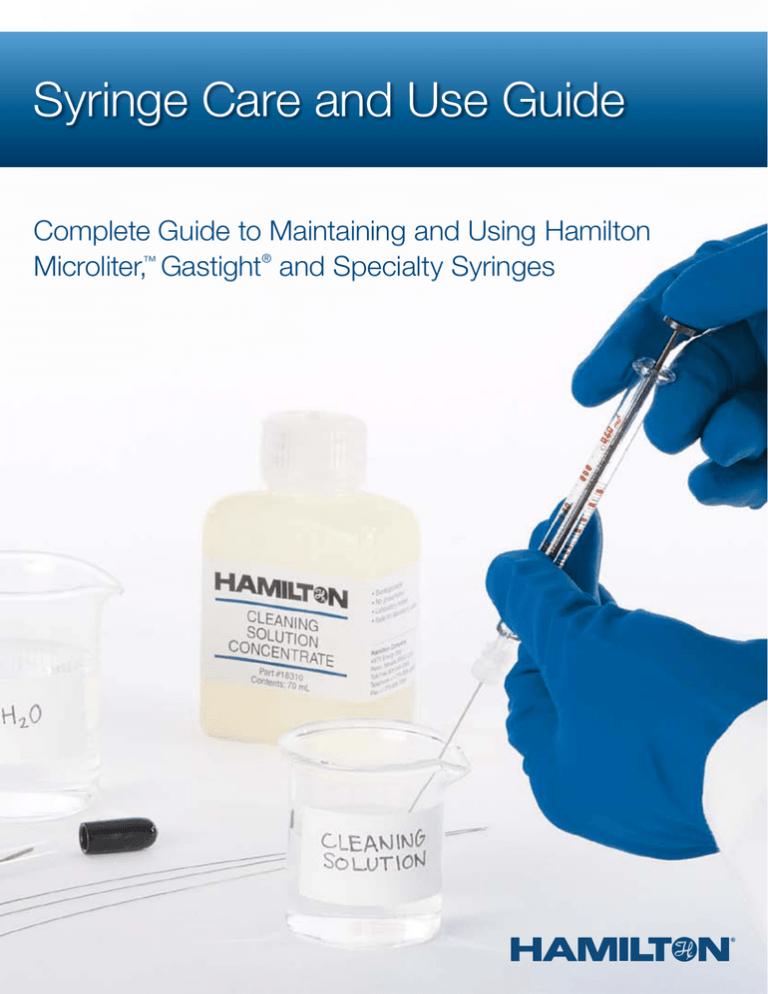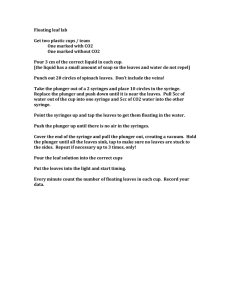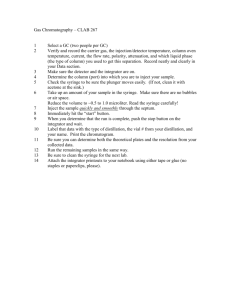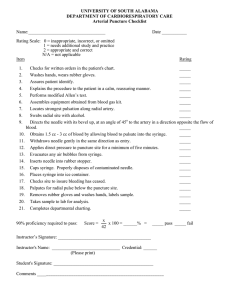
Syringe Care and Use Guide
Complete Guide to Maintaining and Using Hamilton
Microliter,™ Gastight® and Specialty Syringes
TABLE OF CONTENTS
Table of
Contents
Introduction......................................................................................................4
Syringe Use......................................................................................................6
Daily Use Protocol.......................................................................................6
The Basics........................................................................................................8
Cleaning and Care............................................................................................9
Chemical Compatibility................................................................................9
Cleaning......................................................................................................9
Sterilizing, Autoclaving and Disinfecting........................................................10
Plunger Care...............................................................................................10
Needle Care................................................................................................11
Accessories, Replacement Parts and Services...............................................12
Additional Technical Information......................................................................14
Technical Support............................................................................................15
Syringe Care and Use Guide
3
INTRODUCTION
SYRINGE SCHEMATICS
Introduction
Hamilton syringes are the finest quality precision fluid
measuring devices available. Top quality materials and skilled
workmanship ensure Hamilton syringes consistently deliver the
highest possible performance for reliable analyses. With proper
care and handling, Hamilton syringes provide unsurpassed
performance year after year.
This guide covers daily syringe use along with safety
information and troubleshooting tips. Start by reviewing the
syringe schematics and the Daily Use Protocol. Detailed
explanations follow the Daily Use Protocol.
For manual dispenses, our syringes are accurate to within ±1%
of nominal volume with a precision of 1% at 80% of the total
volume. The fluid path of a Hamilton syringe is designed to
be chemically inert with stainless steel, borosilicate glass and
PTFE used for most syringes. N.I.S.T traceable certification
is available as an additional service for the majority of the
syringes in our product line.
4
Examples of Hamilton Microliter and Gastight Precision Syringes
All Hamilton products are unconditionally guaranteed to be free
of defects in materials and workmanship for one year (12 months)
from date of purchase. Hamilton Company is ISO 9001 certified.
Consult our published specifications to determine the material
compatibility of Hamilton products with your application.
Hamilton continuously researches new materials and methods
to improve the form, fit and function of our syringes. You can be
confident that when you buy from Hamilton you are receiving
a top-quality instrument. For the latest information on new
products, detailed product and part descriptions, published
specifications, and our Syringe Selection Guide, please visit
www.hamiltoncompany.com.
700 Series Microliter Syringe
Cemented Needle (N)
Point Style 2 Needle
For liquids
Flange
Plunger
Termination
Point Style
Needle
Graduations
Barrel
For liquids and gases
1700 Series Gastight Syringe
Cemented Needle (N)
Point Style 2 Needle
Syringes and needles manufactured by Hamilton Company
are intended for scientific research and laboratory use only
and are not intended for human in vivo use.
Plunger Tip
(PTFE)
Microliter syringes have a stainless steel plunger which is
individually hand-fitted to its matching glass barrel. The
hand-fitting process is finely controlled to create a liquid-tight
seal between the barrel and the plunger. Plungers for Microliter
syringes cannot be interchanged or replaced if damaged.
Syringe Care and Use Guide
O-Ring
Reference Drawing
(Not To Scale)
Gastight syringes have a precision machined PTFE plunger tip
which provides a tight seal for both liquids and gases.
Replacement plunger assemblies are available for most
Gastight syringes.
5
SYRINGE USE
Syringe Use
Below is a quick review of how to use your Hamilton
syringe to achieve the highest level of accuracy and
precision. Each step of the protocol includes
references to the sections in this guide that cover
specific care and use issues in greater detail.
SYRINGE USE
5. Required Volume
Final dispensing volume
Slowly dispense the excess sample until only
the required volume of sample remains in
the syringe. (See Dispensing, page 8)
6. Final Dispense
Dispense the final sample volume into an
appropriate receptacle. (See Dispensing, page 8)
Daily Use Protocol
1. Inspection
7. Cleaning
Check the syringe for damage such as cracks and dried
residue from previous experiments. (See Syringe Inspection,
page 8 and Dry Microliter Syringe, page 10)
Rinse the syringe with an appropriate cleaning
solvent followed by water and then finish
with acetone. (See Chemical Compatibility
and Cleaning, page 9)
2. Grip
Grasp the syringe by the flange to reduce inaccuracy.
(See Room Temperature and Body Heat, page 8)
3. Priming
8. Storage
Store the syringe in its original packaging
to protect against breakage.
(See Storage, page 8)
Fully prime the syringe by aspirating and dispensing sample to
remove trapped air which can cause inaccuracies.
(See Trapped Air, page 8)
4. Overfilling
Fill the syringe with a small amount of excess sample.
(See Dispensing, page 8)
6
Syringe Care and Use Guide
7
THE BASICS
CLEANING AND CARE
The Basics
Cleaning and Care
Syringe Inspection
Sample Carryover
Before each use, thoroughly inspect the syringe barrel for
cracks and the needle point for burrs. Replace a cracked
barrel with a new syringe. Do not use a needle with burrs.
Burrs may tear GC septa leading to sample loss or poor peak
shape. See more about burrs on page 11.
Eliminate sample carryover by flushing the syringe 5 to 10
times with solvent. Discard the first 2 to 3 solvent washes to
avoid sample contamination.
Room Temperature
Syringes should be used at a constant temperature. Accuracy
and reproducibility specifications are determined at 25 ºC.
Body Heat
Avoid variations in liquid measure due to body heat by
grasping the syringe flange and plunger as you draw and
dispense fluids.
Trapped Air
Eliminate trapped air, which is compressible and affects
syringe accuracy and precision, by completely priming the
syringe with sample. Immerse the needle point 2 to 3 mm into
the sample solution. Then draw and dispense sample into
the solution until bubbles are no longer visible in the syringe
barrel. Alternatively, remove air bubbles by turning barrel
upright and allowing the air bubbles to rise to the needle exit.
Then dispense both the air bubbles and the sample. Clean
the exterior surface of the needle with a lint-free tissue. Avoid
wicking sample with the tissue by making sure it does not
come in contact with the needle opening.
The life of your Hamilton syringe is directly related to
its cleanliness and proper care. In general, solvents
suitable for routine cleaning include methanol,
acetonitrile and acetone. Use solvents of high purity
grade. Halogenated hydrocarbons should not be used
because they may damage some glue joints.
Lubricating Syringes
Chemical Compatibility
Cleaning Agents — Needles
Dispensing
Overfill the syringe and dispense the excess sample until the
desired volume is reached. Visually check to see that the
syringe scale and sample meniscus are parallel. Draw the
plunger back slightly and clean the exterior surface of the
needle with a lint-free tissue. Avoid wicking sample with the
tissue by making sure it does not come in contact with the
needle opening. Then inject your sample.
Storage
Flush the syringe with a solvent in which your sample is highly
soluble. As needed, flush the syringe with other miscible
solvents. Following the use of any cleaning agent, rinse the
syringe with deionized water and then acetone. Clean the
exterior of the syringe if needed. Air dry. Store the syringe in its
shipping box for protection. See the Cleaning and Care section
on page 9 for cleaning agents.
The adhesive used to affix needles and hubs to Hamilton
Microliter and Gastight syringes is the most chemically
resistant available. However, with prolonged exposure, some
solvents may attack and deteriorate this highly resistant
adhesive. In particular, caution should be exercised with
solvents containing halogenated hydrocarbons such as
dichlormethane (methylene chloride). For applications
using these solvents, Removable Needle (RN) syringes are
recommended because no adhesive is present in the fluid
path. Be sure to rinse the syringe thoroughly after each use
with a solvent that is known to solubilize your sample followed
by a solvent such as acetone to ensure that the glue does not
remain in contact with a potentially harmful solvent.
Cleaning
Cleaning Agents — Syringes
To clean Hamilton syringes, it is best to use solvents known to
be effective in solvating the sample. Preferred cleaning agents
are non-alkaline, non-phosphate and non-detergent based.
A biodegradable, non-phosphate, organic Cleaning Solution
Concentrate is available from Hamilton (p/n 18311).
A clean syringe does not require any lubricating grease.
Grease should not be used. The use of grease may lead to a
variety of problems including sample cross-contamination and
seizing of the plunger in the barrel.
Hamilton provides a Needle Cleaning Kit (p/n 76620A). The kit
includes the Cleaning Solution Concentrate described above
and a selection of various diameter tungsten wires to aid in
removing residue in needles.
Clogged Needles
For a partially clogged needle, flush the syringe with an
appropriate solvent to solubilize the clog. For a completely
clogged needle, do not attempt to clean by forcing liquid or
compressed air through the syringe. Excessive pressure will
split the glass barrel. Alternatively, use the Hamilton Needle
Cleaning Kit (p/n 76620A). Start by using the cleaning wires
to dislodge any foreign material. Then flush with the Cleaning
Solution Concentrate to further dissolve the clog. Once the
clog is removed, rinse the syringe and needle thoroughly with
deionized water. Wipe the exterior surfaces of the syringe
barrel and needle dry with a lint-free tissue. Make sure that
there is no residual cleaning agent in the syringe before using
or storing the syringe. For more about storage, see page 7.
NOTE: All solvents used for flushing should be of high
purity grade. Poor grade solvents often contain impurities that
remain in the syringe barrel and cause the plunger to seize or
stick in the barrel.
Cleaning Syringes
Rinse the syringe after use with an appropriate solvent or
cleaning agent. Following the use of a cleaning agent, rinse
the syringe with deionized water and finally acetone. Wipe the
exterior surfaces of the syringe barrel and needle with a lint-free
tissue. Make sure that there is no residual cleaning agent in
the syringe before using or storing the syringe. Do not soak or
submerse the entire syringe in any cleaning agent. Prolonged
contact with cleaning agents may damage bonded parts.
8
Syringe Care and Use Guide
9
CLEANING AND CARE
Sterilizing, Autoclaving
and Disinfecting
Please refer to Hamilton’s published specifications for
each syringe series to determine whether a product
can be autoclaved. Avoid rapid temperature changes,
which can lead to splitting of the syringe glass barrel.
Sterilizing
Hamilton syringes may be sterilized with appropriate sterilizing
agents such as ethylene oxide.
Autoclaving
Chemical sterilizers are the best means for sterilizing syringes.
Hamilton syringes may be sterilized with ethylene oxide. LT,
TLL and disassembled RN syringes may be autoclaved at a
temperature of up to 115 °C. However, repeated autoclaving
will shorten syringe life. When autoclaving is required, remove
the plunger from the syringe. Autoclaving cemented needle
syringes is not recommended as glass and metal expands at
different rates which would compromise the glued connection.
CLEANING AND CARE
Plunger Care
Needle Care
Do not apply force to move a plunger. Too much
pressure can irretrievably bend the plunger or
crack the syringe glass barrel. Refer to the cleaning
instructions on page 9 and the information below.
Use extreme caution in handling needles to avoid
bending, contamination or accidental personal injury.
A variety of needle point styles and lengths are
offered to meet the requirements of different injection
systems. All Hamilton needles are electro-polished to
assure smooth and burr-free products.
Plungers are made of solid material and push
the sample out of the syringe. Hamilton makes
two types of plungers. The plungers on Microliter
syringes are hand-fitted and only liquid-tight. The
plungers are not replaceable for Microliter syringes
except for the 7000 series. The plungers on Gastight
syringes have a PTFE tip and are replaceable. The
PTFE tip creates a gas-tight fit against the interior
of the glass barrel, making these syringes ideal for
gases and liquids.
Dry Microliter Syringes
Always pull liquid into a syringe barrel to wet the interior
surface. Avoid unnecessary moving or pumping of the plunger
in a dry syringe. Excessive dry pumping increases plunger
wear, shortens syringe life expectancy and may lead to
damage beyond repair.
Disinfecting
If your application only requires disinfection, Hamilton
recommends the use of Microcide SQ® (p/n 3995-01). This
disinfectant is rated to eliminate the majority of commonly
encountered bacteria, viruses, fungus and mildew. Use
of other common chemicals like 10% bleach, acetone or
ethanol are acceptable but are not rated to be as effective as
Microcide SQ®.
Touching the Plunger
Avoid touching the plunger with your fingers. Abrasions,
scratches or oil due to handling the plunger with your fingers
may interfere with proper plunger operation.
Accidental Plunger Removal
If the plunger is inadvertently removed from the syringe barrel,
wipe it carefully with a lint-free tissue. Reinsert the plunger
into the barrel and pump deionized water or acetone through
the needle and syringe. In the case of Gastight plungers,
dip the PTFE plunger tip into your solvent to re-wet it prior to
reinserting the plunger into the barrel.
Needle Burrs and Surface
Burrs, rough edges at the needle opening and a rough needle
surface can be removed by gently rubbing with a fine emery
cloth or fine carborundum paper. Make sure to thoroughly
rinse and dry the needle before using.
Needle Bending
Avoid bending needles by selecting the largest needle outside
diameter suitable for your application. Generally, bent needles
cannot be straightened adequately for reliable operation.
Sample Viscosity
Needles are designed to draw samples of normal viscosity.
Samples with higher viscosity may need to be diluted. You may
also consider using a needle with a larger inner diameter.
Dead Volume
Once your sample is dispensed, a small residual amount of
sample remains in the needle. The amount of dead volume
depends on the needle inner diameter and termination style.
For example, with cemented or removal needles, the dead
volume is generally less than 1 µL for small volume syringes
and as much as 6.8 µL for large volume syringes.
Binding Plungers
If the plunger feels like it is binding or rough, it may be soiled
or bent. Do not force the plunger. Try using an appropriate
solvent and wiping with a lint-free cloth. Then follow the cleaning
procedure on page 9 to clean the barrel and try again.
10
Syringe Care and Use Guide
11
ACCESSORIES, REPLACEMENT PARTS & SERVICES
ACCESSORIES, REPLACEMENT PARTS & SERVICES
Accessories, Replacement Parts
and Services
Hamilton offers a variety of accessories to improve durability and reproducibility, including
the ones described below, as well as replacement parts for our syringes.
Details can be found at www.hamiltoncompany.com.
Cleaning Solution Concentrate
Syringe Cleaner
The concentrate is a biodegradable cleaning agent for removal
of stubborn residues. Hamilton part number 18311 (500 mL).
The unit is designed to clean 7000 series Microliter syringes
with only heat (370 °C) or add a vacuum source (0.1 mm
mercury) to remove suspected residuals. Hamilton part
number 76610 (120 VAC) and part number 76615 (220 VAC).
Reproducibility (Chaney) Adapter
The Chaney Adapter is easily installed on a syringe for
consistent, reproducible injections. Also, the adapter
prevents plunger bending while an adjustable stop provides
increased accuracy and precision. Three models are available
to accommodate a range of syringe volumes and series.
Hamilton part numbers 14700 (5–10 µL 700 and 1700 series),
14725 (25–500 µL 700 and 1700 series) and 32146 (5–250 µL
800 and 1800 series).
PB600–1 Repeating Dispenser
The PB600–1 Hamilton part number 83700 can be used with
liquids or gases to consistently dispense 1/50th of the syringe
volume. The dispenser fits Microliter and Gastight syringes with
volumes up to 2.5 mL.
Needle Cleaning Kit
Contains a selection of various diameter tungsten wires as well
as a biodegradable Cleaning Solution Concentrate for cleaning
clogged needles. Hamilton part number 76620A. Additional
cleaning wires and Cleaning Solution Concentrate can be
purchased separately.
12
Digital Syringes are automatically N.I.S.T. traceably calibrated
to the base unit prior to shipment. Recalibration service is
available for the Digital Syringe. Contact. Hamilton Customer
Service Department to obtain an RMA number (Returned
Materials Authorization number). Include the syringe part
number used with the base unit on the RMA and return the
digital unit without the syringe. The customer will be charged
the calibration fee plus the cost of a new syringe.
N.I.S.T. Traceable Certification
This calibration service is available for most of our precision
syringes. A Certificate of Calibration is shipped with the product
and the procedure is performed with an unbroken chain of
calibration with N.I.S.T. traceable weights. Calibrated syringes
must be specified at the time of ordering by adding the prefix
‘CAL’ to the beginning of the syringe’s part number. For
example, to order a 701N, 10 µL syringe Hamilton part number
80300 as a calibrated syringe, request part number CAL80300.
Syringe Guide
The guide is easily installed on a syringe to prevent the plunger
from bending or being pulled out. Two models are offered for
different syringe volumes and series. Hamilton part number
14806 (5–10 µL) and 14906 (25–500 µL).
Digital Syringe
The base unit can be used with Hamilton syringes in the 700,
1700 and 7000 series with nominal volumes between 0.5 µL
and 500 µL. An easy-to-read LCD screen displays the volume
contained in the syringe to within ±0.5% of the syringe nominal
volume. The Digital Syringe is ordered by adding ‘DS’ as a
prefix to the required syringe part number.
Syringe Care and Use Guide
13
ADDITIONAL TECHNICAL INFORMATION
TECHNICAL SUPPORT
Additional Technical Information
Technical Support
The following information is available on our website
in the Syringes & Needles section.
Hamilton Americas & Pacific Rim:
Hamilton Europe, Asia & Africa:
Hamilton Company
Hamilton Bonaduz AG
4970 Energy Way
Reno, Nevada 89502
Via Crusch 8
Ch-7402 Bonaduz, GR
Switzerland
Selecting the Right Hamilton Syringe
We make it easy to choose the ideal syringe for your
application. See step-by-step instructions, a worksheet, and
detailed descriptions in our complete Syringe Selection Guide.
Customer Service
+1 (888) 525-2123
Technical Support/Service
Determining the Performance of
Hamilton Syringes
+1 (800) 648-5950
Follow the protocol on this document to confirm the accuracy
of a syringe. The Hamilton Company Quality System is ISO
9001 certified.
+1 (775) 858-3000
Inner and Outer Dimensions
For applications and projects where the physical dimensions
of a syringe are important, specifications are provided for the
most popular syringes in our product line.
Outside of the U.S.
Customer Service
+41 81-660-60-60
Fax: +41 81-660-60-70
Email: contact@hamilton.ch
Email: sales@hamiltoncompany.com
Frequently Asked Questions
Many of your questions can be answered by visiting the FAQ
located in the Technical Information drop-down menu within the
Syringes & Needles section of www.hamiltoncompany.com.
Product Instruction Sheets
Electronic versions of the documentation shipped with
new products containing information on assembly, use,
replacement parts, etc. Refer to these sheets if you have
misplaced an original instruction sheet or would like to see
more information on a specific product prior to purchase.
Syringe Graduations
Hamilton provides information relating to the scale divisions on
a syringe to the delivery volume. A series of tables detail this
information for all of our syringes.
14
Syringe Care and Use Guide
15
Bleed Image
© 2012 Hamilton Company. All rights reserved.
Microside SQ is a registered trademark of Global Biotechnologies, Inc. in the U.S. and/or other countries.
All other trademarks are owned and/or registered by Hamilton Company in the U.S. and/or other countries.
Lit. No. L20081/05.2012
Hamilton Americas & Pacific Rim
Web: www.hamiltoncompany.com
USA:
800-648-5950
+41-81-660-60-60
Europe:
4970 Energy Way
Reno, Nevada 89502 USA
Tel: +1-775-858-3000
Fax: +1-775-856-7259
sales@hamiltoncompany.com
Hamilton Europe, Asia, & Africa
Via Crusch 8
CH-7402 Bonaduz, GR, Switzerland
Tel: +41-81-660-60-60
Fax: +41-81-660-60-70
contact@hamilton.ch
To find a representative in your area, please visit hamiltoncompany.com/contacts.




